Walking west from Ossington along Argyle Street, the busy noise of tourists and locals quiets to a hum as historic brick houses replace trendy storefronts. This brief few blocks of reprieve leads to Pizzeria Badiali, a self described neighbourhood pie shop at the corner of Argyle and Dovercourt. Since opening in 2021, Badiali has put their stamp on the Toronto culinary landscape by perfecting the quintessential New York slice. While it's almost a rite of passage now to stand in line for a slice, their novel take on pizzeria classics has made them a favourite of everyone from Dave Portnoy to your aunt and uncle. Think creamy burrata dolloped on a rich marinara slice, or earthy crushed black pepper on a Cacio e Pepe white pizza. At the heart of the operation is Ryan Baddeley, the fine dining chef turned pizza purveyor whose commitment to authenticity and simplicity has helped establish Badiali as a new standard for quality pizza in Toronto.
I often talk with my friends about the best pizza in the city and Badiali regularly comes up as one of the best slices, and they usually add the caveat that the line is long, but it’s worth it. I’m wondering if you’ve embraced the long lineup and view it as a tangible marker of your success?
Yeah, when we opened I didn't really know what to expect. It wasn't my background, but I knew I wanted to create a very cool neighborhood place for people to come and grab a slice, but I didn't know that it was gonna hit the ground running as hard as it did. When the line started they had nowhere to go and honestly it became a daily stress point because we also weren't skilled pizza makers ourselves so we were kind of learning as we went. Did we want to be the shop that just does slices or be the shop that does whole pies? We were kind of feeling things out and I think we quickly realized that people were loving the slices. It was difficult in the beginning because we’re working in an open kitchen environment, so having the line added pressure. The space wasn't designed to do as much pizza as we ended up doing. I don’t think people realize how small it is on their first visit. It’s a 550 square foot pizzeria, so it’s pretty tight. What we are capable of doing is actually pretty impressive considering the size, but I don’t think people totally understand that we run out and they can’t just walk up and grab a slice within an hour on a Saturday. We've learned over the past few years how to deal with the volume of customers better and the line is a trademark now. It’s at the point now where if there’s no line when we open I’m like, “are we done?”
You mentioned pizza making isn’t your background. Can you talk a bit about how you started as a chef? You learned your culinary skills at George Brown and staged at some high profile restaurants.
I went to university briefly at Laurier, but realized it wasn't my thing and dropped out. I was really interested in cooking growing up, but it just didn't seem like a career that was a normal route to take. So once I dropped out of Laurier, I moved to Toronto and started working in some kitchens. For a long time I was working at Bar Isabel and opened Bar Raval, so I was with that group for a while and had a lot of experience cooking European food. I spent some time in Italy doing some butchery apprenticeships. I was pretty well-rounded as a cook and pizza was something that I never cooked before, but had some interest in. Like, I’d go to New York with friends and I really loved the culture of going to eat a slice everywhere. Every corner has a pizzeria and everybody's competitive but friendly. It’s just part of their culture. It's almost like coffee here. I just always loved eating slices whether it was in New York or Italy, and I always thought it was something I might want to get into later on in my career after doing some chef jobs and kind of settling down: opening a pizza shop where it wouldn't take so much day-to-day work in the kitchen. Then I opened Osteria Rialto, part of Paradise Theater one and a half months before COVID. It had taken about two years to get it to the point where we were ready to open, and when we opened our sales were just steadily inclining, and then it was right back down at the starting mark.
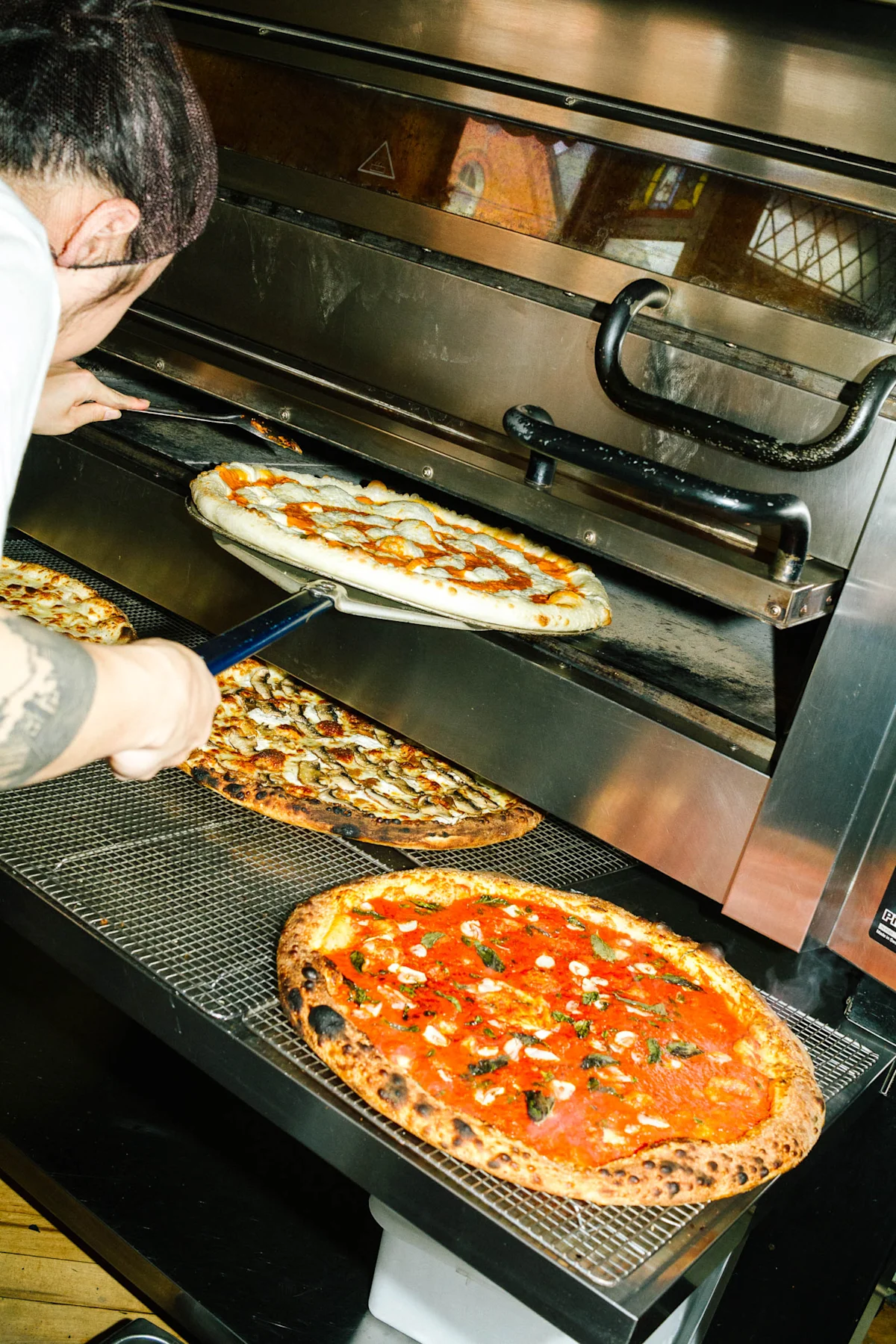
What kind of food were you making there? Was it Italian?
It was Italian. It was pasta with very good high-end ingredients. We were making plans to make our own pasta – we had an extruder. They’ve done all that now, and it's shaped up to be that kind of restaurant, but I think when COVID happened it really shook a lot of those high-end restaurants into forming into something that they weren’t anticipating. I just kept hearing about pizzerias crushing it and sushi places doing take out. They're all COVID proof and at the same time within that late 2020 period so many restaurant spaces became available and no one wanted a restaurant because of the uncertainty. I lived on the same block as Badiali for many years up until just this fall, on the other corner, so I've always loved the corner building. It really reminded me of a lot of those corner restaurants in Brooklyn, or pizzerias and cafes that had a lot of beautiful history in the building, so I knew I wanted to do something when I saw it was up for sale. I had some thought of doing a pizzeria, but I didn't really have the idea before I saw the space was available, and I didn't want to do it anywhere else. We were really fortunate to get the space because I wasn't gonna look elsewhere in the city.
So then you made the decision that you're going to do this?
I initially thought it would be a bit of a side project, and that I’d create a pizza menu and we would do slices. I never expected the overwhelming demand for it. It quickly became real, that this was going to be my full-time job, and we just started looking for ways to not run out of pizza for about two years, because that was our biggest problem. I kind of laugh thinking about how much pizza we were making in the beginning, because it wouldn't even get us through two o'clock. In the beginning we had the basement space where I was doing the dough in the morning, and then I would go upstairs and I would cook everything. After finally getting a commissary space we now separate where we do our production and prep of the dough and all the sauces, and we send stuff down every day.
Have you calculated how many pizzas you make a day?
Yeah, it's around four hundred.
That's a lot of pizza. Now, we’re just approaching the laundromat on Dovercourt St., where you used to live, and I’m wondering if you can walk me through the early days in your home kitchen: how did you source and test your ingredients, your sauces and cheese, and how did that translate to what you do now?
I lived on top of the laundromat during the pandemic, but just prior to that I traveled to New York and Italy a couple times and collected aspects I liked from different pizzerias. Since I had never worked in a pizzeria before, I was able to pick from all these parts of all these pizzas – not necessarily New York style, or Neapolitan, or Roman – and I was able to put something together that was the best hits of my perfect pizza. Upstairs, I had a really old gas oven that could get up to 550 degrees with a real flame broiler, and I had a pizza stone and a pizza steel, and I would start the pizza on this steel and have the stone just underneath it so that it would replicate a deck oven situation. For that New York style pizza, I’d give it a seven or ten minute bake and serve it to friends during dinner parties, just figuring out dough, and what toppings worked on different doughs.
You mentioned using a pizza steel, and in Badiali you still cook with a screen. Can you explain what the difference is between using a screen and a stone?
If you go to New York pizzerias, every person is just such a pro. It looks like they've been doing it, and probably have been, for about fifteen to twenty-five years, whereas Toronto just doesn't have that pizza culture and so I find that if you're gonna grow and take on new employees that the screens are a great way to help facilitate volume within pizzerias. It just creates less chaos within a small environment. If you have a lot of space that would be one thing, to do the stretching on peels and walking around with it, but to put out a high volume in a tight environment the screens are an easier way to start pizzas – not necessarily finishing them. I think that it does take away from what you can do to a crust when you cook directly on a screen fully, but I don't think screens are a terrible way to do it, because it facilitates a perfect even pizza.
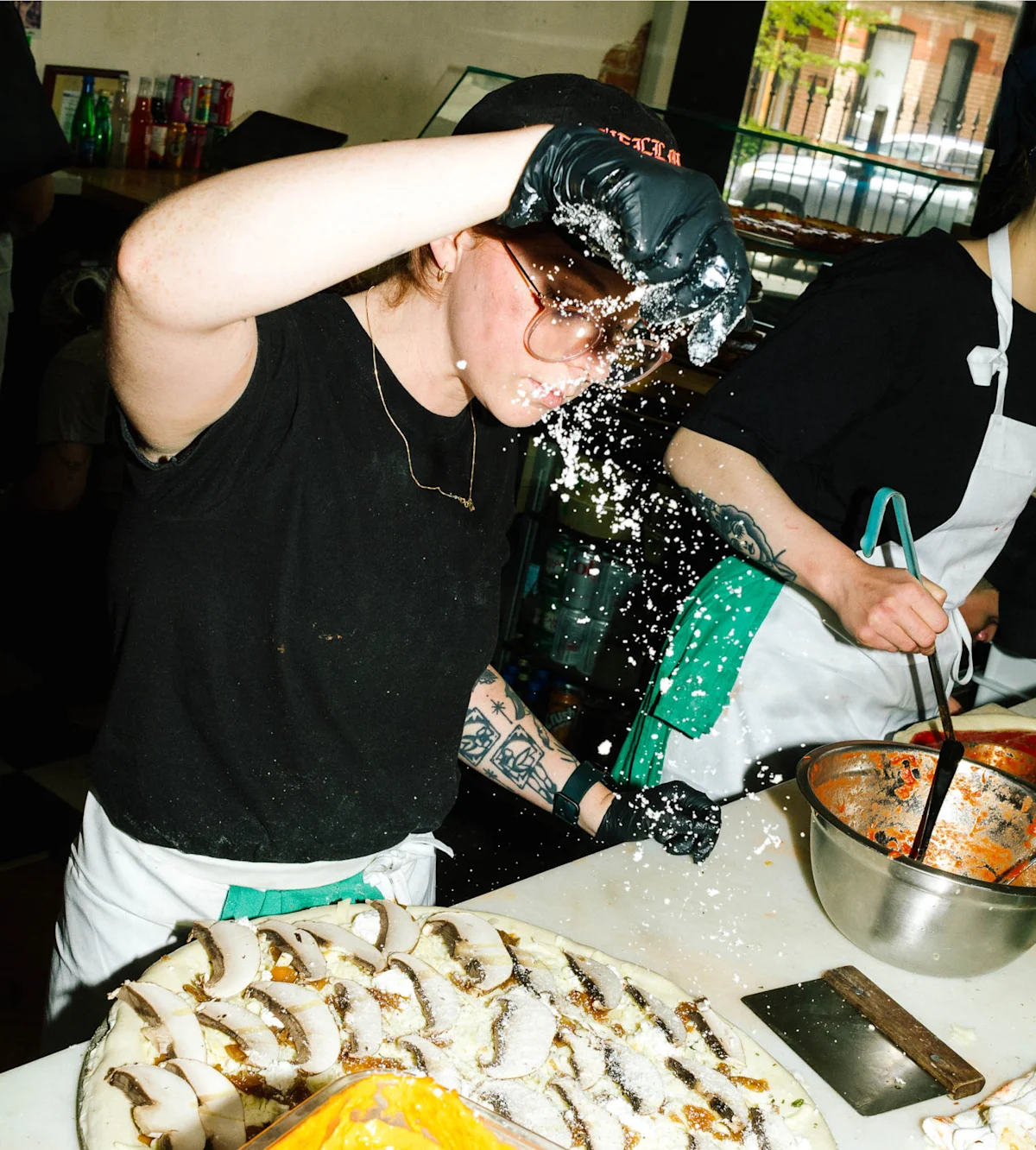
Is that kind of frowned upon in some pizza circles?
I would say 100%. In terms of New York, big time. You'll find a ton of pizzerias finish with screens, because, you know, they might have been too hot initially, but it's rare to find higher-end pizzerias that start on screens. I would say if you know how to use them properly, you can get an amazing product out of it still. So for me, it was never a compromise.
And you use two different kinds of tomatoes for your sauce?
Yeah, I mean, I do flip a little bit through different types of tomatoes, depending on what we can get. When you start going through a lot of volume, you hit patches in the year. But yeah, typically California tomatoes, and I like a textural difference, so I use a crushed and a whole tomato that we blend.
I’m wondering how you developed the standard menu that you have day in and day out, and how that changes, if it does, seasonally?
Initially, I wanted to do classics, and I think I opened up with everything pretty classic, but since I have a chef's background, I started wanting to expand a little bit. You know, we have a cacio e pepe slice, then shortly after year two, we put on the salami and hot pepper, which started as a slice that was our favorite to eat from the kitchen; taking some salami that we had been doing with a salad and then adding these great pickled hot peppers. But I think we typically stick to the classics. I like to rotate through some specials throughout the year following the seasons. Basically I like to do riffs of really good pastas that I like and turn them into pizzas. So like pasta alla norma, we do a spicy eggplant, we do alla gricia, we do cacio e pepe with asparagus, next week we’re doing ramps, potato, and bacon. A close friend of mine, Keenan McVey from Blue Goose Farms, always gives me some stuff in the summer that helps out with our summer specials.
This area of the city that Badiali is located in is a unique culinary hotspot. There’s Bernhardt's up the street using produce from around Ontario, then there's a handful of restaurants on Ossington like Actinolite, Côte de Boeuf, and Union. What is it about this specific zone that attracts restaurants?
When I first moved to Dovercourt, the only things that were here were Julie's Cuban which had been there forever, and Cafe Luna in the space that we now occupy. Back then Ossington was still hitting its stride in the restaurant scene and was just getting really popular. It was definitely a place where people from the neighborhood would go at night, but also starting to attract people from the outside. Then, a couple of years in – when Bernhardt’s took over the building Julie’s Cuban was in – Dovercourt itself became a destination, and I realized that I would love to have a pizzeria on the street. It’s kind of become its own unique thing. You have Dunda above us, Queen street below, and Ossington to the east, so we get a lot of foot traffic wandering in and out of these streets. It spread by word of mouth, people saying “do you know about Dovercourt? Do you know how cool Dovercourt is?”
There’s quite a storied pizza history in Toronto that dates before my time living in the city, where a contingent of Vietnamese immigrants who worked at Massimo’s pizza spread out when that imploded and carried on the Toronto tradition. [There’s even a Wikipedia entry for it.] What is your association with Toronto pizza culture?
What’s funny is that, even though now my life is a lot about pizza, growing up it was more about becoming a cook in fine dining restaurants. So, I had a very different relationship to pizza back then. Especially in my 20s. You got pizza after working for 12 hours a day, or you got it after the bar at 2am. You were getting Pizza Gigi because it was hot, and you had a bit of a buzz on. It was serving that purpose. I think that's what a lot of the independent pizzerias were about in Toronto up until recently: that perfect mom and pop style pizza. I love that style, but you gotta eat it when it's hot, and it doesn't age well. But, you know, there's still something about going to Bitondo’s or Fresca and getting a slice that I do really love, and I think is an important part of our city, and any city, to still have those older pizza places.
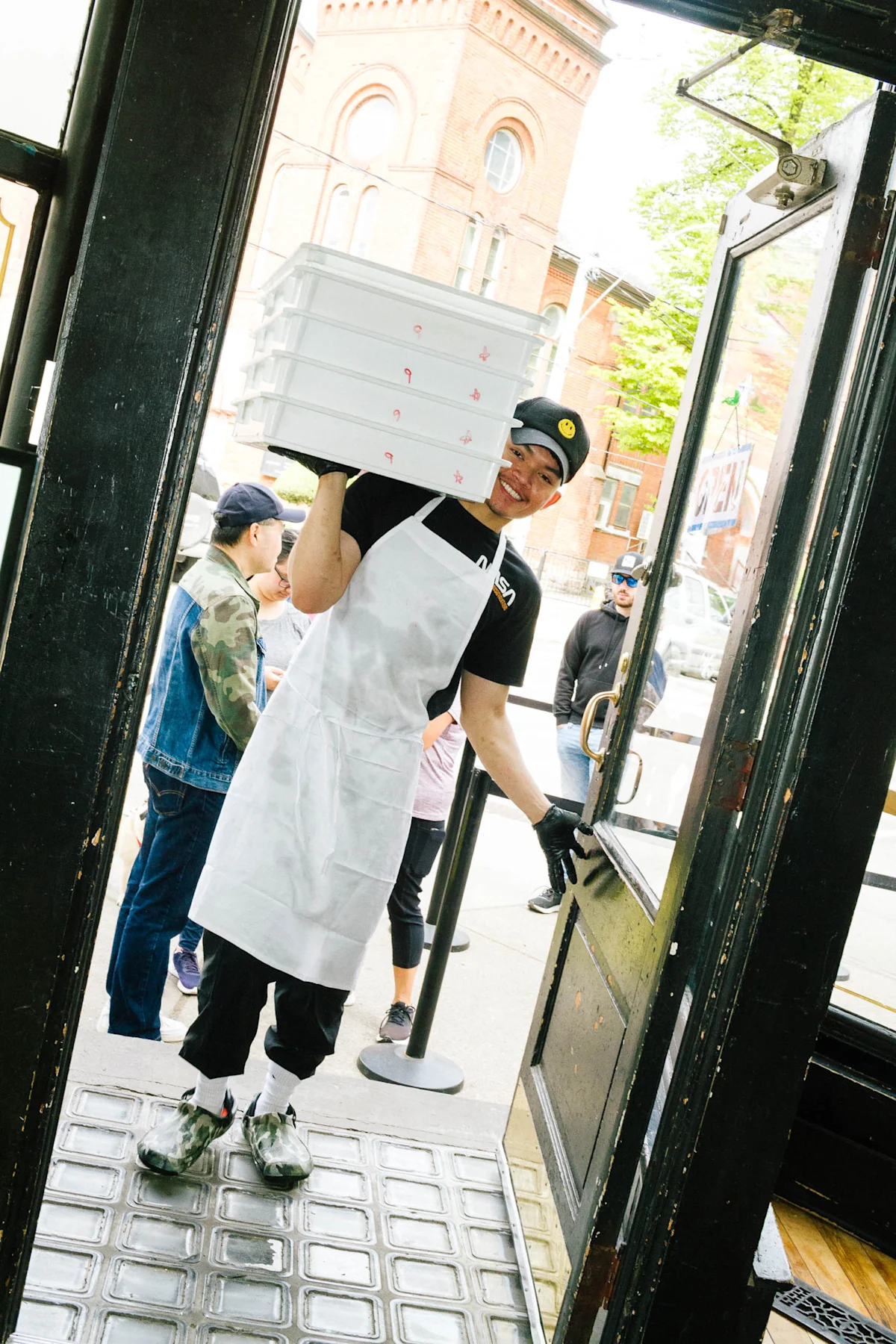
I know that there's always a lot of talk about pizza ratings and what's the best slice, and then when Dave Portnoy came to the city in 2022 and did his pizza tour there was a really buzzy energy in the city.
Yeah, it was funny, it was like you could definitely feel it when he announced that he was coming and everyone was like, “oh my God, he's coming!” I think it worked out well for us. It was our second year, maybe eight months in, and we finally had figured out how to do things and everything was going well.
So it came at the right time? It didn't slam you too hard?
Well, I mean, it didn't exactly come at the right time, because the week he came my dough guy got COVID. I was freaking out a bit about that. I was just like, of course it's gonna happen this week. To be honest, I wasn't freaking out about him coming. I knew that he would probably like our pizza. I was confident that he would come and give us a good rating and he did, and I was super happy about it, but it was definitely funny to see the city all hyped up about it. He had his groupies, and they were all waiting for him to come in. So it was fun to see that for sure.
What do you think about how publications like Now Magazine rate pizzas and the kind of general restaurant ranking culture?
I mean, I'm happy to be included in everything. Pizza is one of those things, like hamburgers, where everyone does them well. It's just, what do you really like? We do something that's really good by the slice, and I think that a lot of people appreciate that.
[Random pedestrian yells “Best pizza in the city!”]
Oh, thanks buddy! I think they do a really good job of making the lists for pizza, and it's overall good for everybody involved. Honestly, pizza culture is just getting better in Toronto. There's a lot of great places to get pizza now that weren’t here ten years ago. We're definitely trending in the positive direction.
Where do you think Toronto is at in terms of restaurant culture and people trying new things?
I have conversations about this with friends and chefs all the time, but Toronto is an amazing place to eat at all levels. I think that our middle level dining is probably the best in the country in terms of the amount of really casual, but really good restaurants where you can sit down and have a meal that’s not going to break the bank. We do have an amazing amount of that, and it kind of stretches to all cultures and all different types of cuisines, which I think is amazing. You can also eat extremely good here, cheap. We have an amazing few Chinatowns around the city and the GTA. There's Korea town. We do have these pockets that have some amazing cuisines. It is harder with our longer winters to sustain some things. For example, a big grief about restaurants in Toronto is patios. Hiring for how busy you are in the summer and then losing that business in the winter really hurts the stability of keeping staff. You train staff every year for those summer months because business will triple, and then you have to find a place for them, or let a lot of people go in the winter when everything slows down. So it's really tough in that sense. Whereas in places like Florida or California, you can keep people year round. But, overall, Toronto is an amazing place to eat.
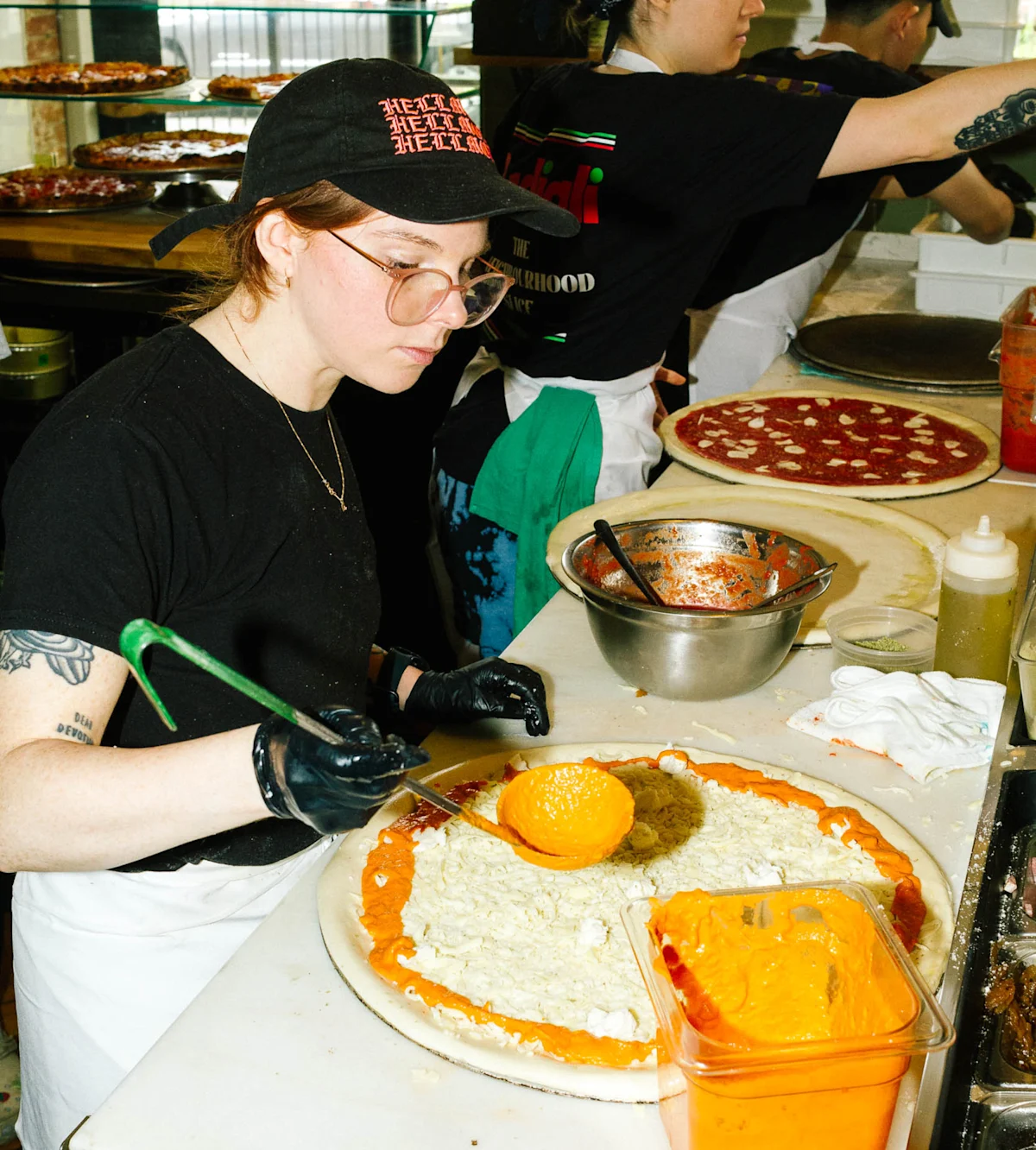
What do you think it takes to open a restaurant in Toronto and then turn it into a success?
Toronto, in terms of opening restaurants, is getting a little bit more difficult these days with the prices of rent going up. I worked for Grant van Gameran a long time ago and a lot of his peers – this was maybe fifteen years ago – were able to open restaurants for under a hundred thousand dollars. It's just not something that you can kind of do anymore without a lot of backing. Products cost a lot more money. Rent is insane now. If you're putting yourself in areas where there is foot traffic or restaurant scenes, they're definitely going to be a lot of money for rent. You just have to be confident in what your concept is and it has to be pretty proven. It can't be as much of a risk as it used to be. If you’re someone who has worked in restaurants for a long time in the city and you have a concept, and you've done a couple pop-ups and they've been successful, then you have a chance. I had confidence just with my background and working in restaurants and in my partners, whereas I would find it a lot more risky if it was my first restaurant and I wasn't necessarily from the city.
Do you believe that if you make it well, people will come?
50% is if you make it well, they will come for sure. I still think that is accurate. Products will speak for themselves in terms of people finding you and enjoying what you do. I think that did happen with us a little bit. Also our location is great and it does speak to that pizza place that everyone wants where you can grab a slice in a beautiful part of town on a little hidden street. But I think that there's a lot of other things that have to line up in order for it to 100% work.
It is a calculation, but it sounds like you decided that this was the spot, and if it's not this spot, then it's not this concept.
For sure. I've had to mould the concept a little bit. It was obviously supposed to be a small thing and now we have twenty-five employees and I have amazing managers and an amazing couple of partners that help me run the business daily. But, you know, social media, photography, it's a total package. It's a different world than it was fifteen years ago when you could just open a restaurant on a few credit cards and try to get a little menu going. The population definitely knows what they like now.
Do you think you'll ever franchise?
No, we'll never franchise, but we'll definitely do another location and we got one coming up at the end of this year, TBD.
Growth is important.
Growth is important, as is supporting the team and letting my managers grow a little bit and having everybody who's been here for a good amount of time have a future. So, growth is important, but also getting to a point where we can control things to the equality standpoint where things don't move far away from what they are now, so that Badiali is still a great slice ten years from now.
I always wonder about this with chefs and their restaurants: how much pizza do you eat?
It's a great question. I find it varies week to week. I would say I'm pretty good with like three to four slices a week, which probably sounds like a lot, but it's really not considering how many times I pop in here. And also if you do work here every day, you're eating more than that for sure.
What do you normally do if you're not here making pizza?
Our commissary space is at Weston Road, north of St. Claire, and that's where we do all the dough and sauces. We opened that maybe just under a year ago. It basically allows us to never run out of pizza before we close. Even with last year we were finding that we would end up running out of slices by 7 pm. We were able to cook some whole pies for people, but we were just running out way too early and missing out on a lot of business, and also upsetting people that waited in line, because when they reach the end they find out that we don't have any more pizza. We were storing everything in the basement and now we're delivering every day, so I make sure everything's going well at the commissary, then pop down here, hang out for a bit, make sure everything's going well, and support anyone that needs it. My partner Nick runs all the back-end money and payroll and I take care of day-to-day business.
So we have our slices here, what are some of the qualities that make a good pizza slice?
Honestly my biggest thing is balance, as with any food. There's got to be a good cheese to sauce ratio. There's got to be a good chew to crisp ratio. It also depends on the slice. If you've got the salami hot pepper, how much spice do you want versus how much sweetness with the tomato? We finish a lot of our slices with pecorino and parmesan to get that last rich salty bite. With the specials we're always tinkering with how to finish them, whether it's a little drizzle of honey, or a sherry vinegar with leeks and a really rich French cheese.
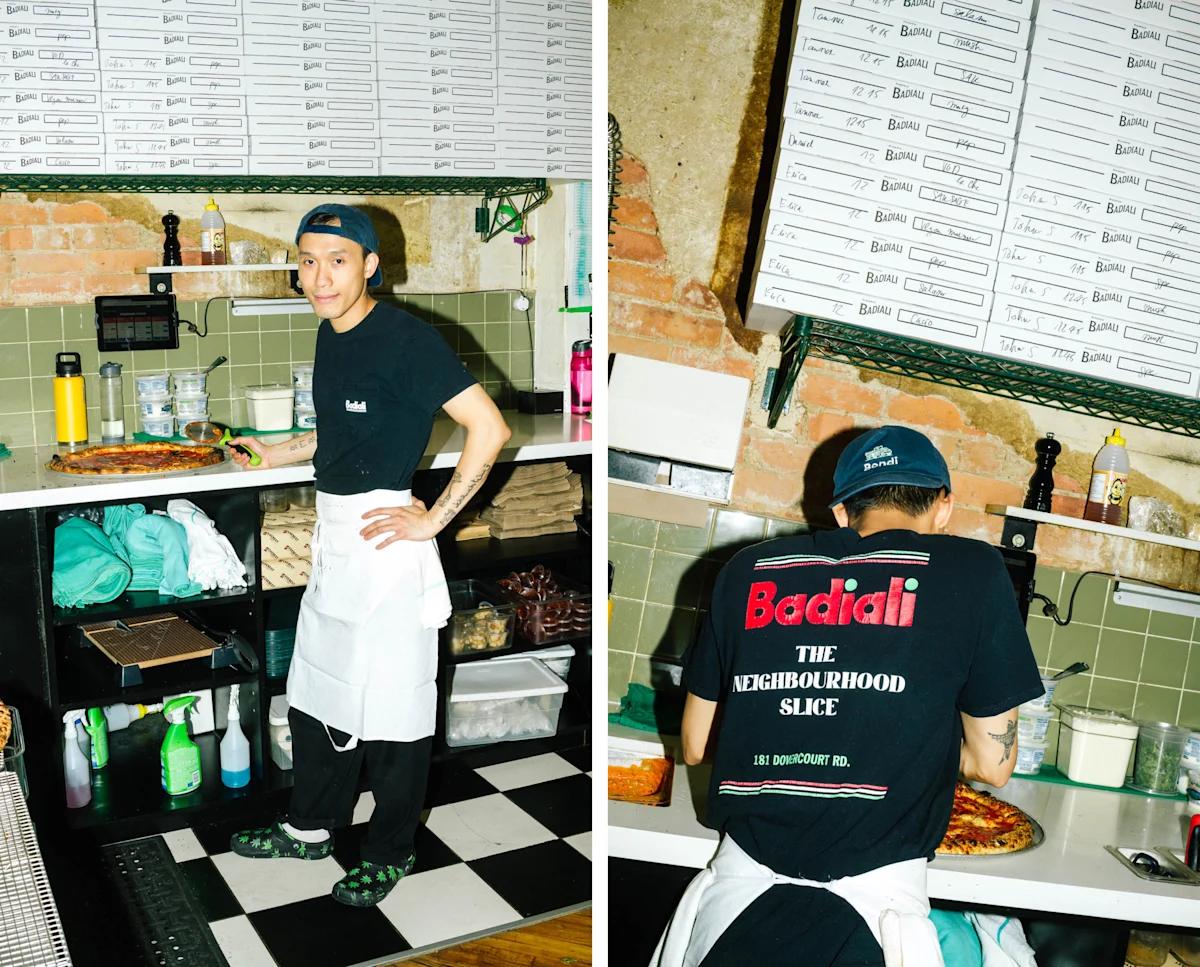
That comes back to the exploratory nature of being a chef.
With that I'm always showing the staff, you know, a little less sauce on this particular pizza, because of the balance, a little more on this pizza. If we're doing the Capicola and pineapple, the pineapple juice means you don't need as much tomato, or else it gets a little too juicy. When you’re just putting your head down as a pizza cook, you can forget the way things work sometimes, but because of my chef background I think about the whole picture, the whole plate.
So you do a lot of finishing, like you’re saying, at that final stage before you plate the pizza?
Yeah, totally. We'll take the marinara slice, we'll put some burrata on it and finish it with a little olive oil, so you get those final extra fatty notes. I think the dough itself is the biggest thing. The thing that makes pizza really stand out is the dough quality. If you do a good dough the rest will kind of fall in line. You can always learn how to cook it properly, you can always learn how to top it better, or use better ingredients, but if you don't have a really good dough recipe, that makes all the difference. It’s always the biggest translator to a good pizza in my opinion. Ours is a three-day process. We do a poolish method and we use a few different types of flour. It's very simple ingredients – olive oil, salt, yeast, and flour dough – but there's a lot of steps and temperatures. As dialed-in as we have it, consistency is still a day-to-day thing. It's always changing.
So what kind of things are you looking to do next? You mentioned you’re opening another location down the road.
Yeah, there’s a couple things. You know, we're never fully happy with what we have and we always like to keep pushing it in terms of quality. For the dough, myself and Tyler, our dough guy, we're always talking about different flours that we want to try. We just recently went to the Vegas Pizza Expo and we were talking to some new people that were bringing in some flours to Canada that haven't been here yet. So we try to keep tinkering with the dough recipe and see if we can dial it in even more than it already is. We use two different kinds of flour. One’s a double zero, a very specific pizza flour, and we also use a bread flour that is specific to long fermentations and keeps a lot of oxygen in the dough for lightness. I like to eat a lot of pizza, so I don't want to eat dough that's really heavy. Having something that can be light, crispy, and a little chewy, but not too heavy, is kind of the goal. It’s all about trying different variations and formulas. I'm always seeing new products come into Canada’s growing pizza market. More and more cheeses are coming in. More pepperoni. More jarred specialty items are becoming available. So we’re constantly growing with them. Then also the second location. It'll be a little bit bigger but along the same lines as this one with a slice shop. Just figuring out what we’d do if we had more space.
Last question: dip or no dip?
Personally, I wasn't a dip guy, but I think dip is the restaurant form of soft-serve ice cream: you have an opportunity to do something really good. Especially with my background as a chef, I feel like I have a little bit of an edge to do something that's a little bit more special than just a standard garlic dip. So, we have a few. I don't do many, and I don't like going too crazy with the dip, so I keep it pretty tight and traditional, but I mean the first time I had a slice with pepperoni and hot honey on it I was blown away with how good it was. So I do understand the dip culture and I think that, as a business, it's something that you just start missing if you're not doing dip.
It's a statement if you don't.
There's been so many times where I see an order go out with two pizzas and nine dips. It's like, I get it. You love it. You love the dip! So yeah, it's something that I personally don't use a lot of, but if you have a good crust, you gotta celebrate it.
– East Room is a shared workspace company providing design-forward office solutions, authentic programming and a diverse community to established companies and enterprising freelancers. We explore art, design, music, and entrepreneurship. Visit ournews & stories page to read more.